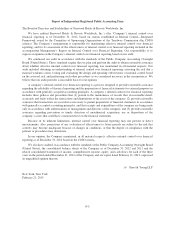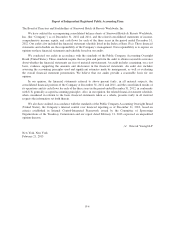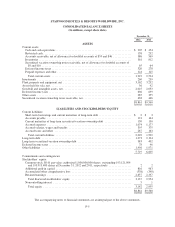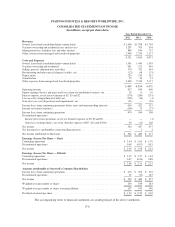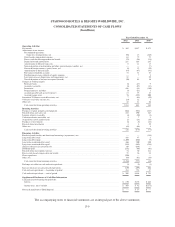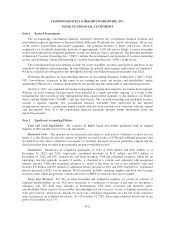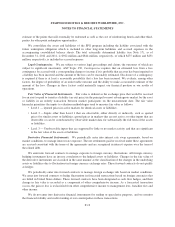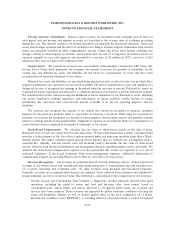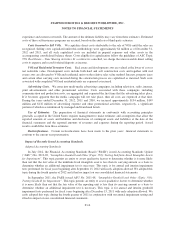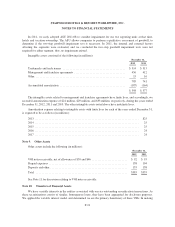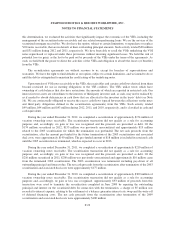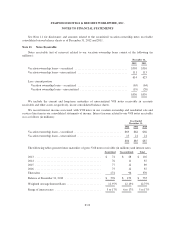Starwood 2012 Annual Report Download - page 170
Download and view the complete annual report
Please find page 170 of the 2012 Starwood annual report below. You can navigate through the pages in the report by either clicking on the pages listed below, or by using the keyword search tool below to find specific information within the annual report.STARWOOD HOTELS & RESORTS WORLDWIDE, INC.
NOTES TO FINANCIAL STATEMENTS
estimate of the points that will eventually be redeemed as well as the cost of reimbursing hotels and other third-
parties for other point redemption opportunities.
We consolidate the assets and liabilities of the SPG program including the liability associated with the
future redemption obligation which is included in other long-term liabilities and accrued expenses in the
accompanying consolidated balance sheets. The total actuarially determined liability (see Note 17), as of
December 31, 2012 and 2011, is $922 million and $844 million, respectively, of which $275 million and $251
million, respectively, is included in accrued expenses.
Legal Contingencies. We are subject to various legal proceedings and claims, the outcomes of which are
subject to significant uncertainty. ASC Topic 450, Contingencies requires that an estimated loss from a loss
contingency be accrued with a corresponding charge to income if it is probable that an asset has been impaired or
a liability has been incurred and the amount of the loss can be reasonably estimated. Disclosure of a contingency
is required if there is at least a reasonable possibility that a loss has been incurred. We evaluate, among other
factors, the degree of probability of an unfavorable outcome and the ability to make a reasonable estimate of the
amount of the loss. Changes in these factors could materially impact our financial position or our results of
operations.
Fair Value of Financial Instruments. Fair value is defined as the exchange price that would be received
for an asset or paid to transfer a liability (an exit price) in the principal or most advantageous market for the asset
or liability in an orderly transaction between market participants on the measurement date. The fair value
hierarchy prioritizes the inputs to valuation methodologies used to measure fair value as follows;
• Level 1 — Quoted prices in active markets for identical assets or liabilities.
• Level 2 — Inputs other than Level 1 that are observable, either directly or indirectly, such as quoted
prices for similar assets or liabilities; quoted prices in markets that are not active; or other inputs that are
observable or can be corroborated by observable market data for substantially the full term of the assets
or liabilities.
• Level 3 — Unobservable inputs that are supported by little or no market activity and that are significant
to the fair value of the assets or liabilities.
Derivative Financial Instruments.We periodically enter into interest rate swap agreements, based on
market conditions, to manage interest rate exposure. The net settlements paid or received under these agreements
are accrued consistent with the terms of the agreements and are recognized in interest expense over the term of
the related debt.
We enter into forward contracts to manage exposure to foreign currency fluctuations. All foreign currency
hedging instruments have an inverse correlation to the hedged assets or liabilities. Changes in the fair value of
the derivative instruments are classified in the same manner as the classification of the changes in the underlying
assets or liabilities due to fluctuations in foreign currency exchange rates. These forward contracts do not qualify
as hedges.
We periodically enter into forward contracts to manage foreign exchange risk based on market conditions.
We enter into forward contracts to hedge fluctuations in forecasted transactions based on foreign currencies that
are billed in United States dollars. These forward contracts have been designated as cash flow hedges, and their
change in fair value is recorded as a component of other comprehensive income. As a forecasted transaction
occurs, the gain or loss is reclassified from other comprehensive income to management fees, franchise fees and
other income.
We do not enter into derivative financial instruments for trading or speculative purposes, and we monitor
the financial stability and credit standing of our counterparties in these transactions.
F-13


